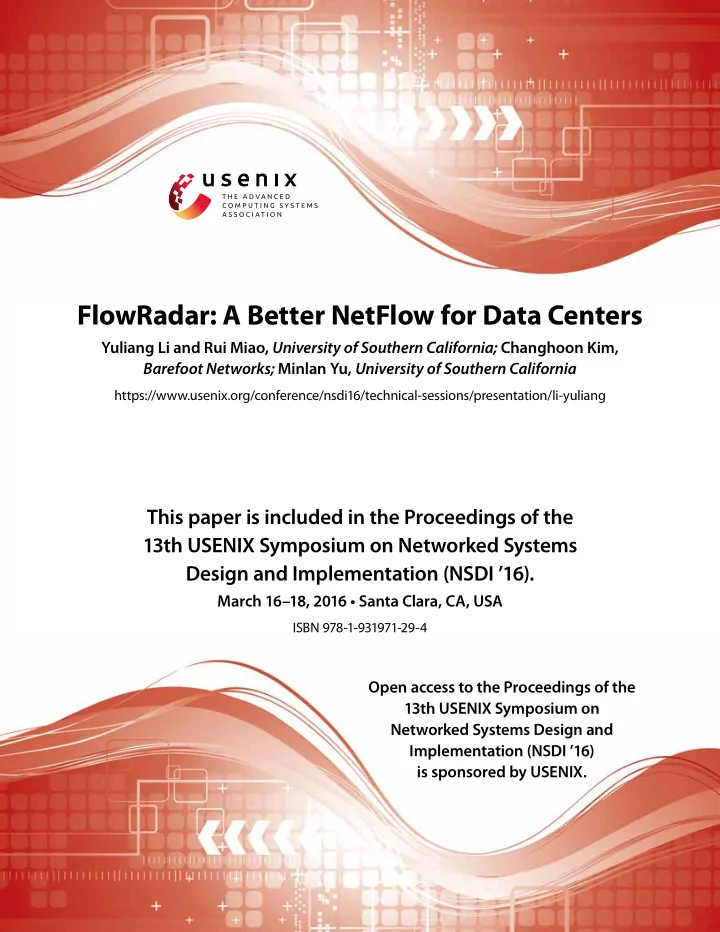

FlowRadar: A Better NetFlow for Data Centers Yuliang Li and Rui Miao, University of Southern California; Changhoon Kim, Barefoot Networks; Minlan Yu, University of Southern California https://www.usenix.org/conference/nsdi16/technical-sessions/presentation/li-yuliang This paper is included in the Proceedings of the 13th USENIX Symposium on Networked Systems Design and Implementation (NSDI ’16). March 16–18, 2016 • Santa Clara, CA, USA ISBN 978-1-931971-29-4 Open access to the Proceedings of the 13th USENIX Symposium on Networked Systems Design and Implementation (NSDI ’16) is sponsored by USENIX.
FlowRadar: A Better NetFlow for Data Centers Changhoon Kim † Yuliang Li ∗ Rui Miao ∗ Minlan Yu ∗ † Barefoot Networks ∗ University of Southern California Abstract plement NetFlow in hardware is how to maintain an ac- tive working set of flows using a data structure with low NetFlow has been a widely used monitoring tool with time and space complexity. We need to handle collisions a variety of applications. NetFlow maintains an active during flow insertion and remove old flows to make room working set of flows in a hash table that supports flow for new ones. These tasks are challenging given the lim- insertion, collision resolution, and flow removing. This ited per-packet processing time at merchant silicon. is hard to implement in merchant silicon at data cen- To handle this challenge, today’s NetFlow is imple- ter switches, which has limited per-packet processing mented in two ways: (1) Using complex custom silicon time. Therefore, many NetFlow implementations and that is only available at high-end routers, which is too other monitoring solutions have to sample or select a expensive for data centers; (2) Using software to count subset of packets to monitor. In this paper, we observe sampled packets from hardware, which takes too much the need to monitor all the flows without sampling in CPU resources at switches. Because of the lack of us- short time scales. Thus, we design FlowRadar, a new able NetFlow in data centers, operators have to mirror way to maintain flows and their counters that scales to a packets based on sampling or matching rules and ana- large number of flows with small memory and bandwidth lyze these packets in a remote collector [26, 40, 44, 34]. overhead. The key idea of FlowRadar is to encode per- It is impossible to mirror all the packets because it takes flow counters with a small memory and constant inser- too much bandwidth to mirror the traffic, and too many tion time at switches, and then to leverage the computing storage and computing resources at the remote collector power at the remote collector to perform network-wide to analyze every packet. (Section 2) decoding and analysis of the flow counters. Our eval- However, in data centers, there is an increasing need uation shows that the memory usage of FlowRadar is to have visibility of the counters for all the flows all the close to traditional NetFlow with perfect hashing . With time. We need to cover all the flows to capture those tran- FlowRadar, operators can get better views into their net- sient loops, blackholes, and switch faults that only hap- works as demonstrated by two new monitoring applica- pen to a few flows in the Network and to perform fine- tions we build on top of FlowRadar. grained traffic analysis (e.g., anomaly detection). We need to cover these flows all the time to identify transient 1 Introduction losses, bursts, and attacks in a timely fashion. (Section 3) In this paper, we propose FlowRadar, which keeps NetFlow [4] is a widely used monitoring tool for over 20 counters for all the flows with low memory overhead years, which records the flows (e.g., source IP, destina- and exports the flow counters in short time scales (e.g., tion IP, source port, destination port, and protocol) and 10 ms). The key design of FlowRadar is to identify the their properties (e.g., packet counters, and the flow start- best division of labor between cheap switches with lim- ing and finish times). When a flow finishes after the in- ited per-packet processing time and the remote collector active timeout, NetFlow exports the corresponding flow with plenty of computing resources. We introduce en- records to a remote collector. NetFlow has been used for coded flowsets that only require simple constant-time in- a variety of monitoring applications such as accounting structions for each packet and thus are easy to implement network usage, capacity planning, troubleshooting, and with merchant silicon at cheap switches. We then decode attack detection. these flowsets and perform network-wide analysis across Despite its wide applications, the key problem to im- time and switches all at the remote collector. We make USENIX Association 13th USENIX Symposium on Networked Systems Design and Implementation (NSDI ’16) 311
Recommend
More recommend